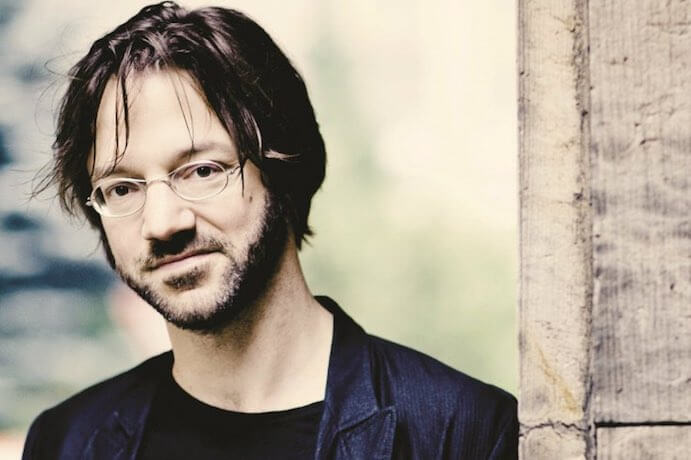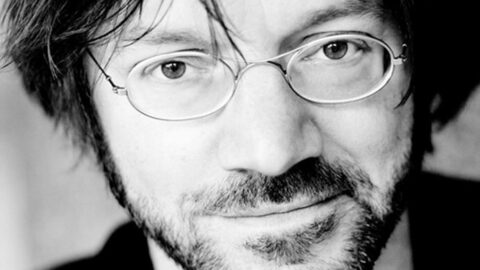German conductor André de Ridder (b. 1971) regularly collaborates with top contemporary music ensembles and artists including the London Sinfonietta, Ensemble Muusikfabrik de Cologne, and his own stargaze collective. He performs regularly at international festivals around the globe. In Finland, de Ridder has conducted the Tapiola Sinfonietta, and most recently, Kaija Saariaho’s opera Émilie presented at the Finnish National Opera. He is the Artistic Director of Musica nova Helsinki 2017, and we asked him 5 questions to learn more about the upcoming festival.
Congratulations on your first program as Artistic Director of Musica nova Helsinki! Can you briefly summarize some of the highlights of this year’s festival?
Thank you!
My highlights… the European premiere of Andrew Norman’s Grawemeyer awarded Play in the opening concert (this is a last-minute addition actually!). The first weekend 3.-5.2. in a new state-of-the-art venue in Helsinki called G Livelab–with a more informal, jazz club-like atmosphere–which presents a kind of mini-festival within the festival around electronica-oriented contemporary music and composers from different disciplines. Our artists of the weekend include Tyondai Braxton, Jan St. Werner of Mouse on Mars withthe Finnish Korvat Auki Ensemble, Qasim Naqvi (of Dawn of Midi) in the role of a composer, and Matthew Herbert as well as the Finnish ensemble Uusinta.
A spirituality related programme in Helsinki’s extraordinary “church in a rock,” Temppeliaukio Kirkko, with three different groups (Kamus Quartet, Helsinki Chamber Choir, and Osuma Ensemble) with works by G. Ligeti, Grisey, and Bryce Dessner, all tracing themes of light and darkness. Michel van der Aa‘s composer feature, including his brand new one-woman opera (soprano Katherine Manley) Blank Out, an immersive 3D music and film theatre piece.
And the visit of Lukas Ligeti, of course.
Musica nova Helsinki is Finland’s largest contemporary music festival with events spanning 12 days. Where do you begin when curating an event of this length, and how do you sustain excitement over the course of the festival?
It all starts with a big meeting of all the major organisations in classical music in Helsinki and around. The special and wonderful thing about Musica Nova is that all of them come together around a table and all contribute to the project. We incorporate and respect everyone’s opinion, and I have to convince everyone of a certain vision but also happily listen to their suggestions and expectations. I started with looking at what’s been done and what hasn’t had much exposure in Finland, but also what’s already being planned around that time. For example, I was approached about the Ligeti Symposium possibly happening around that time, or even becoming entrenched in the festival. This resonated with some general ideas I had around the notion of space–musical, acoustic, and outer space–and this led to a lot of other paths that then somehow all started to connect. A stream of consciousness that hopefully can be traced when “journeying” through the festival…Hopefully we can sustain the audience’s enthusiasm by showing different facets of certain composers in different concerts and contexts (rather then putting them all in the same programme) and spanning an arc from beginning to end of the 12 days, with interjections and clashes. Different ensembles in one concert can be a tool for that, though costly…
Musica nova Helsinki boasts an international roster of performers and composers, but can you tell us more about some of the young featured Finnish musicians?
The Finnish Radio Orchestra and the Public Broadcasting Company YLE are amazing for their support and performance record of young Finnish composers, as they regularly give a new generation of composers opportunities and commissions. So this will be no different, and a strong feature of the opening concert: Both Sebastian Hilli and Sauli Zinojev have recently come through the Sibelius Academy. Sebastian Hilli’s piece just won a major international composition prize in the Toru Takemitsu Competition, and it will be heard for the first time now in his home country. He and Sauli Zinovjev represent a fluent and very accomplished style of writing, not adhering to any schools, geographically or stylistically.
Outi Tarkiainen is an example of a multi-faceted composer working comfortably in the jazz as well as classical contemporary idiom, and a combination of both!
Composer/Performer Erkki Veltheim is a different case: he left Finland in his youth, and is an equally great performer on viola and violin. First, he lived in Berlin (he played with the Berlin Phil and Ensemble Modern) and then settled in Melbourne, Australia, becoming an important figure in the contemporary and improv scene there. Certainly a very individual voice who found his own path entirely! This will be a sort of homecoming, and hopefully a discovery for the Helsinki audience.
Then there is Islaja–a singer/songwriter with a very interesting range of projects–who will collaborate with defunensemble and their artistic director, composer Sami Klemola.

You seem to be very cognizant of both musical and physical space with this year’s programming. In your opinion, how does the relationship between the music and the venue affect the audience experience?
I just enjoyed discovering certain spaces in Helsinki where you can stage concerts. In some cases, I immediately thought of works to perform there, so the experience of a place has influenced the programming actually!
But regarding the audience: in my experience, a special architectural and acoustic space sets one’s mind up for a heightened experience before a note has been played. Then, it is an interplay between the visual, acoustic, and musical content experience. It can become a more festive, celebratory, or close-up to the performers’ intense or social experience. Feeling a shared appreciation of the music with other audience members is normally more the hallmark of going to a rock or jazz gig. Nowadays, contemporary music is often performed in very small rooms or technical, box-like environments. This can make it a little “dry” sometimes, but it can be appropriate for certain styles or pieces. An interesting situation appears when you’re allowed to walk and move around during a concert–for example, in an art museum with different performance spots where you might also take in the exhibited artworks. But especially, I think the free movement has quite an impact on how the music affects you (physically in fact) in a positive way, unless you’re put off by other people’s movements of course…
Nevertheless, I am still a fan of the wonderful concert halls we have nowadays–which were specifically built for orchestras and ensembles–and it’s much harder to find ways to make audiences who are not so familiar with these classical music events enter those venues than it is to fill a club with a curious, kind-of-hip audience for some “crossover” marketing or a classical-lounge where some big record label puts their new violinist signing on show. We gotta work on the former. Mind you, I’ve only seen the Music Centre’s main hall in Helsinki filled to the brim, so far.
Has your experience programming Musica nova Helsinki given you any new ideas/perspectives regarding spreading contemporary music to a wider audience?
Well, in a way, my practice so far has probably informed the reason for being invited to curate Music Nova, so I wanted to try and incorporate this thinking in the programme, both through musical choices as well as the places and buildings we perform in. I think I will be a bit or hopefully a lot wiser AFTER the event, if we have achieved this, or are on the right track to doing so… Then I’ll give it another go, or adapt, in 2019!
























